
Contemporary Music Instruction and Mentoring
Choosing and Caring for Cords
and Wireless Systems
GENERAL INFORMATION ABOUT CORDS
1. My general advice is don’t buy cheap cords. They
may sound okay, but they don’t last. They are always
breaking at inopportune times, and then you look like an
idiot running around on stage trying to find a spare.
Besides, cheap cords end up costing more in the long run
because they are always dying and being replaced.
2. Always bring a spare of every type of cord you use, to
every gig. Even with quality cords, something can go
wrong.
3. With any cord or cable, if you will learn the proper way
to plug it in, unplug it, and wind it correctly, and take
the time to always do so, and not allow other people who
don’t know how to do it correctly to touch it, it will last
much longer. This applies to both quality cords and
also for cheap cords. Ask Irv to show you the proper
over-under cord winding method, or link here to see a
YouTube video explaining how to do the over-under cord
winding method: How
to Wind Cables
MIC CORDS AND SNAKES
Most musicians use the cheapest mic cords
they can find. I also did this for decades.
Finally, I got fed up with a mic cable or two breaking every
gig, either before or during the performance, and 7 channels
out of 24 on the snake going dead over a couple of
years. I got tired of having a pile of mic cords on my
desk waiting for me to get out the soldering iron to fix
them. So I threw every single mic cord and the snake
into the garbage and bought all-new, quality cords. I
even bought them in custom lengths to reach various parts of
the stage, and labeled them. That was 10 years ago,
and I’ve not had a single mic cord or snake channel go bad
since. It’s well worth it.
The cords I recommend are EWI Starline microphone
cables (below). They are excellent, reliable, and
reasonably priced.
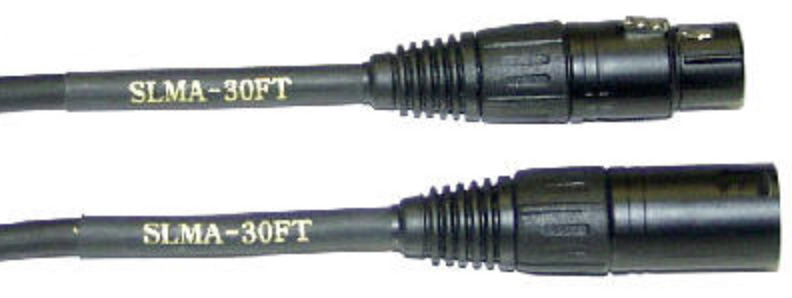
They are
available only from Audiopile: https://www.audiopile.net/starline-microphone-cables
For excellent, reliable, affordable snakes, I recommend EWI
snakes, which are also available only from Audiopile: https://www.audiopile.net/stage-snakes
WIRELESS MIC SYSTEMS
What if you want to be cordless on stage?
What are the best systems to replace mic cords, and what are
the tradeoffs?
In the past, cordless mics were horrible. They had a
loud hissing noise, poor frequency response in the high
register, terrible signal to noise ratio, and pathetic
dynamic range. In fact, it is not an exaggeration to
say that the worst corded mic sounded better than the best
cordless mic. However, in just the last few years,
huge improvements have been made in digital cordless
technology. Today, there are cordless systems for
which the drop in sound quality is low enough that it is
hardly noticeable in live performance. The downside is
that those systems are VERY expensive. Even today,
most inexpensive cordless mics sound absolutely horrible.
If you insist on a cordless mic, please LINK
HERE and scroll down for a full discussion of
cordless mic systems. To briefly summarize, I do not
recommend cordless mics. Instead, I recommend cordless
transmitters that plug into standard mics. The best
affordable transmitter/receiver I'm aware of is the Xvive
Audio U3 (below left). Sweetwater recommends it.
The specs sound good: it has 24 bit processing, excellent
frequency response, low noise, low distortion, plenty of
channels, and both the transmitter and receiver run off
rechargeable batteries that charge with a USB cord, like a
smartphone. You just plug the transmitter into the end
of your microphone instead of a cord, and plug the receiver
into the snake or the mixer, instead of a cord. This
system sells for $200 at Sweetwater and gets 5 stars on
Sweetwater and 4.5 stars Amazon.
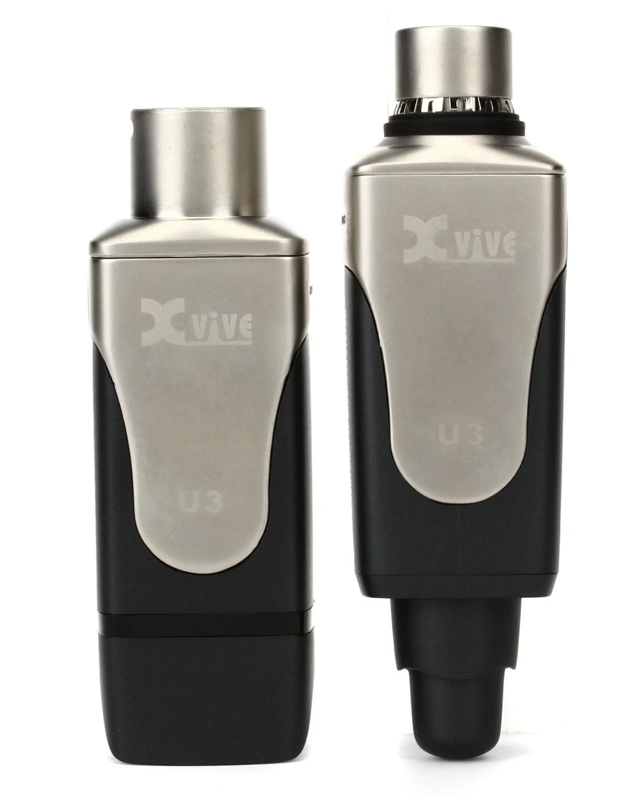
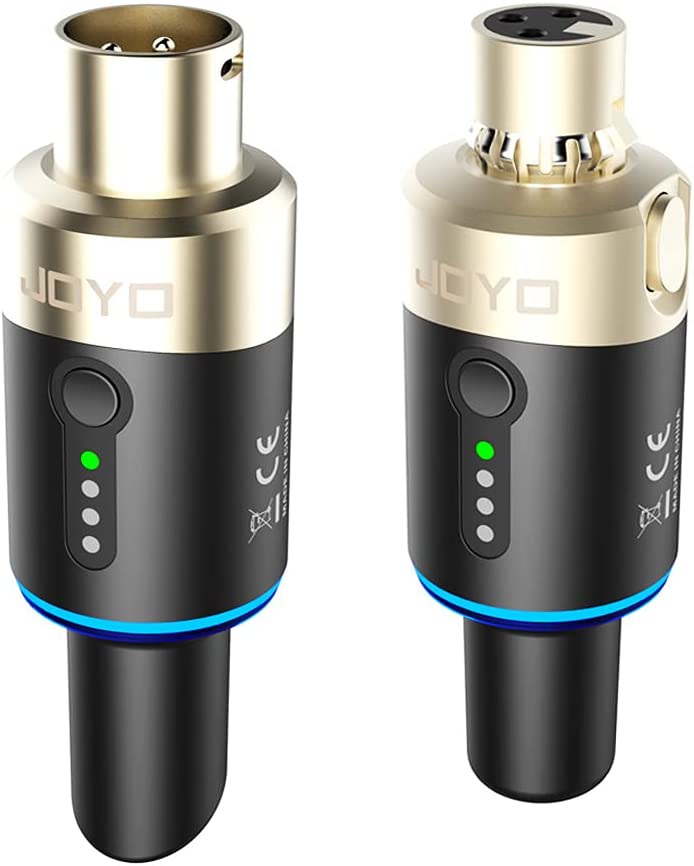
A less expensive system is the Joyo (above right),
for about half the price of the Xvive. It gets decent
reviews and 4.4 stars on Amazon. Sorry, I haven't
personally tried either the Xvive or the Joyo, so I cant say
whether the Joyo is as good as the Xvive.
If you choose to use a cordless system, here is a
hard and fast rule that you should never break: Always run a
cord from your place on the stage to the mixer or snake
(acoustic guitar). Don't plug it in, but have it
there. If a battery goes dead, or a transmitter or
receiver goes bad, or a nearby router or cell phone or other
device starts making radio noise on that frequency during
the gig, you can plug the cord into the mic and into the PA
in 10 seconds and be back in business. Always
remember, even the best wireless systems can have problems
during a gig.
GUITAR/BASS/KEYBOARD CORDS
Before you buy any guitar/instrument cord, the first thing
you need to understand is the difference between a
guitar/instrument cord versus a speaker cord. All
guitar/instrument cords have plugs on the ends that look
like this:
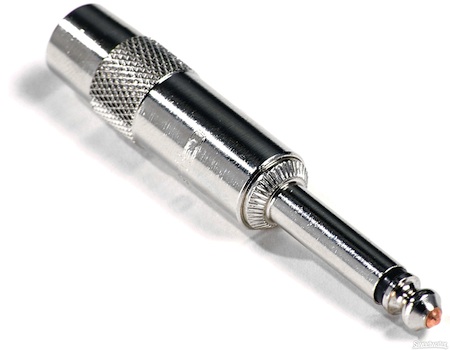
These plugs are usually called "quarter inch
plugs" because the part that plugs into the jack is exactly
.25" (6.35mm) in diameter. They are also called “TS”
plugs (meaning "Tip/Sleeve") because they have a tip (the
end of the plug past the black plastic ring) and a sleeve
(the long connecting part on the other side of the black
plastic ring). They are also called “phone jacks”
because they were invented by the telephone company and were
used by telephone operators in the 1920-1950 era.
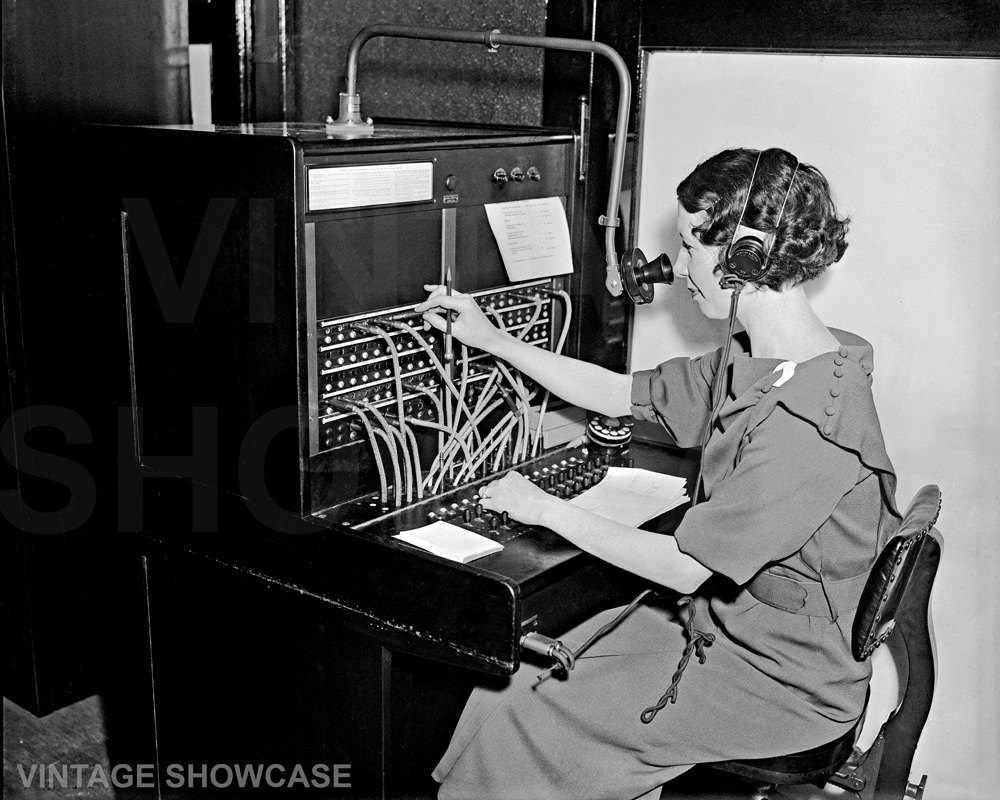
Sadly, some speaker cords look exactly like
guitar cords, with quarter inch/TS/phone plugs on both ends,
but THEY ARE NOT THE SAME as guitar cords and they
are not interchangeable. The guitar cord
is made with a very small, thin wire in the middle and a
braided wire shield around it. The thin wire is
actually composed of many extremely thin wires that make it
flexible, but even with all those tiny wires together, it is
still VERY thin (usually 24 gauge).
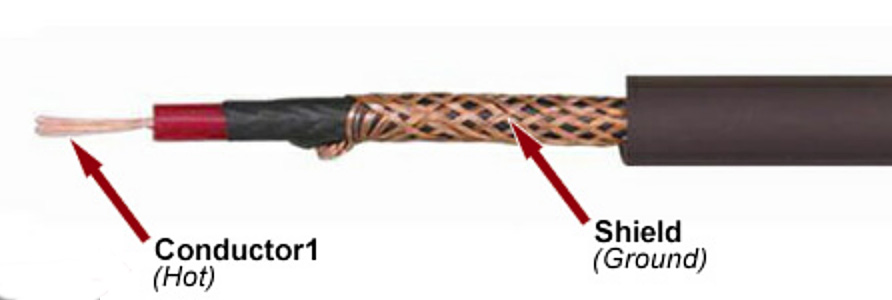
In contrast, a speaker cord is made with two thicker wires
that are the same gauge as each other, with no
shielding. They are surrounded only by rubber:
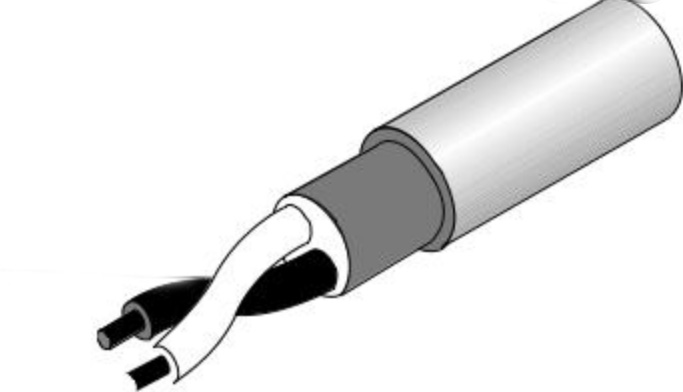
The problem is, from the outside, these two very different
types of cords look identical. So just because you
have a cord with 1/4" plugs on the end does not mean it is a
guitar/instrument cord! If you try to use a speaker
cord for a guitar or instrument, you will hear all sorts of
static and noise because the signal is not shielded, and the
two unshielded wires act like a radio antenna.
Conversely, you try to use a guitar/instrument cord for an
unpowered speaker (running from an amp to a speaker, not
from a mixer to a powered speaker), the thin wire is unable
to carry enough current and the sound will not be as loud
and the dynamic range will be limited. Worse, the cord
will heat up, like an old Christmas Tree extension cord
plugged into a 1500W space heater. So pay attention,
and label the cords when you buy them.

Here are my recommendations for
guitar/bass/keyboard cords:
Inexpensive guitar/instrument cords
For excellent, reliable, affordable cords that are great for professional use, made by the same company as the mic cords recommended above, I recommend EWI GBNC Premium Series cords with Neutrik straight ends (below). They sell for $19-21 and are available only at Audiopile:
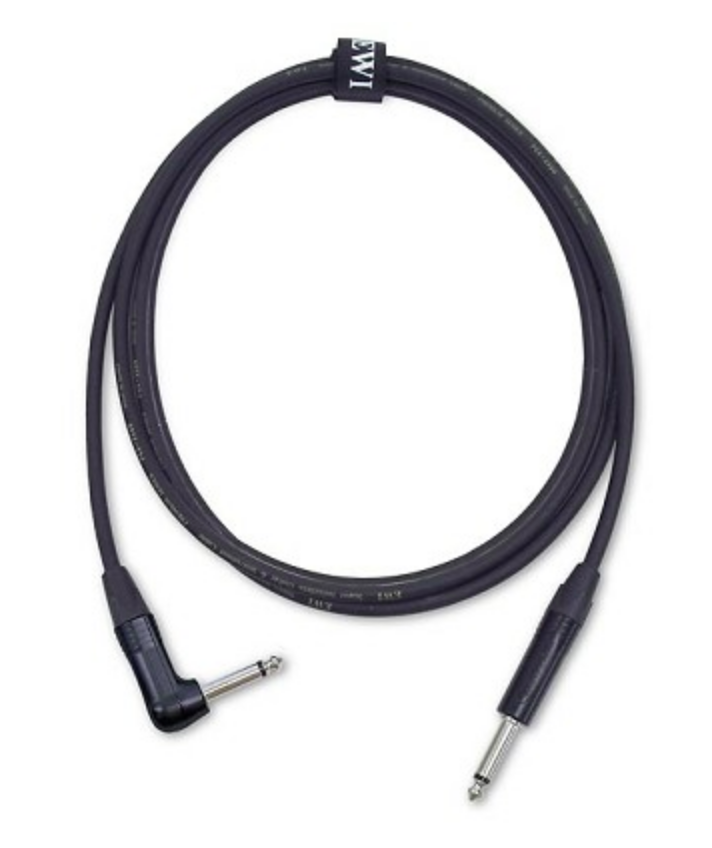
12’, 15’, 18’ https://audiopile-net.3dcartstores.com/GBNC
The best guitar/instrument cords money can buy
The very best cord is the George L .155.
They are expensive, but for quality and longevity, they are
worth the cost.
I have been using George L .155 cords exclusively
since 1982, for all my keyboards, basses, guitars, and
effects. I have dozens of these cords; some are 40
years old, some are 20, some are 10, and some I just bought
last year, and I can't tell the new ones from the old
ones. They have been gigged and gigged and
gigged! Out of all those cords, I have had only a few
go bad in those 40 years... but here's the kicker: I've
never had to throw one away. You can repair them in 60
seconds: just loosen the screw, pull the end off, snip 1/2
inch off the end of the cable, reattach the end, tighten the
screw, and it’s as good as new. George L .155 cables
are thin (they are only a little thicker than the bottom
string in a 5 string bass!), but they are VERY strong.
Mine have been abused by PA amp cabinet wheels running over
them, heavy keyboard stands smashing them, and so on, and
they keep working! The ends are also incredibly
strong! I have never heard of one breaking off while
in the jack and someone trips on the cord. Not many
cords can say the same. They coil well, they are
tough, they don't take a lot of space in your gig bag, and
they sound better than (or at least as good as) ANY other
pro cord because they have excellent shielding, high quality
copper core wire, gold plated ends, and extremely low
capacitance. You can make them any length you
want. You just order two ends plus whatever length of
cable you want, and assemble it yourself. It takes 2
minutes to assemble.
NOTE: I do not recommend the George L. right-angled plugs, except for a pedalboard application. Nor do I recommend the brass plugs, because they tarnish and that ruins the sound. The stainless steel plugs are okay, but I recommend that you use only the straight, gold plugs (below):
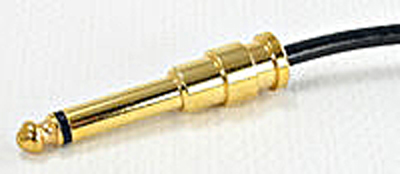
Buying these cords direct from the manufacturer
(georgelsstore.com) is a pain. They don't offer custom
lengths and their prices are ridiculously high.
Sweetwater has some George L kits but does not offer custom
lengths nor do they offer gold plated ends. The best
place to buy them that I have found is at vantageguitarshop
on Ebay.
Straight Gold Plated Ends (2 plugs per cord, sold
in pairs, so order 1 pair per cord) https://www.ebay.com/itm/114728369689
Black .155 Cable (enter as the "quantity" the total length in feet of all the cords you want... you can cut them yourself) https://www.ebay.com/itm/115108438168
These are not cords for students on a budget, but for a gigging musician they are the best way to go. A 15’ George L cord costs about $19 for the ends plus $33 for the cable, for a total of $52, which is within a few dollars of the price of a d’Addario “American Stage” cord and premium cords from other manufacturers. George L's have the best sound, are easiest to stow away, are repairable (on stage, without a soldering iron, in seconds, with only a pair of scissors and a small screwdriver), and last the longest of any cord on the market. BALANCED VS UNBALANCED CORDS
Guitar and instrument cords are
"unbalanced." In an unbalanced cord, the inner wire is
the hot, and the surrounding braided shield is both the cold
and the ground. In other words, the inner wire and the
shield wire are both conductors that carry the signal.
Thus, the shield serves a dual purpose: to carry the signal
AND to shield the hot signal wire. This is fine for
running short distances, but this design is not good for
going more than 20 feet or so. Most guitar cords are
15 feet long, and you don't want to go much farther than
that with an unbalanced cord. If you do, there will be
a noticeable loss of volume, especially in the treble, and
the instrument will sound muddy.
For longer distances, it is necessary to use a
"balanced" cord. Microphone cords are
"balanced." The inside of a balanced cord looks a lot
like a guitar cord, but instead of one thin wire in the
middle, there are two thin wires in the middle, one for hot
and one for cold. Both are surrounded by a shield,
which is connected to ground, that serves ONLY as a radio
frequency shield, and does not carry the signal.
Balanced cords can go hundreds of feet without signal loss.
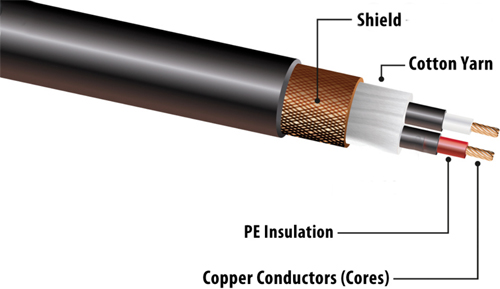
There is one more thing that needs to be said
about balanced cords: they can have two different kinds of
plugs on the ends. Most balanced cords have XLR plugs
on the ends. These are the ends used on microphone
cords, and they look like this:
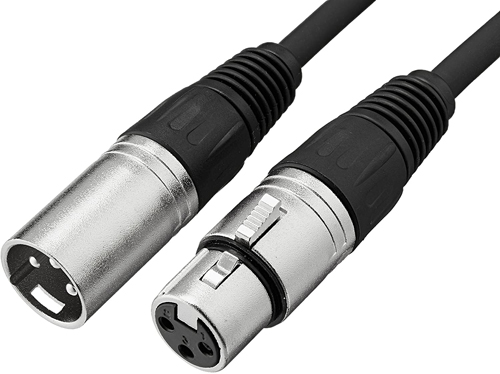
On an XLR plug, pin 1 is ground (shield), pin 2 is
hot, and pin 3 is cold.
The other kind of plug that can be on a balanced
cord is another type of quarter inch plug, called a "TRS",
which stands for Tip / Ring / Sleeve. They look like
this:
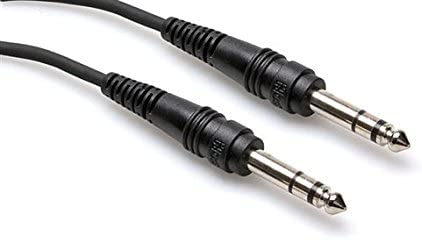
On a TRS plug, the tip is hot, the middle section (called
the "ring") is cold, and the sleeve (the section closest to
the rubber) is ground (shield).
(NOTE: These are exactly the same plugs that are
used on professional headphones, but headphones are not
shielded. In that usage, the tip is left +, the ring
is right +, and the sleeve is - for both left and
right. They are also used for "insert jacks" on
mixers. In that case, the tip is send +, the ring is
return +, and the sleeve is three things: send -, return -,
and shield.)
DI BOXES
To convert a signal from
unbalanced to balanced is the job of a "DI", which stands
for Direct Input. The DI is a small box with a 1/4"
jack on one side and a male XLR jack on the other
side. You plug your guitar cord into the 1/4" jack,
then plug a mic cord into the other side, and run the mic
cord to the snake or the mixer. Inside the DI box is a
transformer that converts the signal to a balanced format.
There are a lot of different DI boxes with a wide
variety of prices. The higher priced "active" DI's
have all sorts of fancy features, but they do not do the job
of converting from unbalanced to balanced any better than a
good quality "passive" DI, which is much less
expensive. Since converting from unbalanced to
balanced is the only job required of a DI, the active DI's
are pretty much a waste of money for most applications.
For an excellent, reliable, affordable DI box, made by the same company as the mic cords recommended above, I recommend EWI FDB-101 One Channel Passive Direct Input Box. It has every feature you need, and none you don't, and it's a better quality than many DI's at double its price.
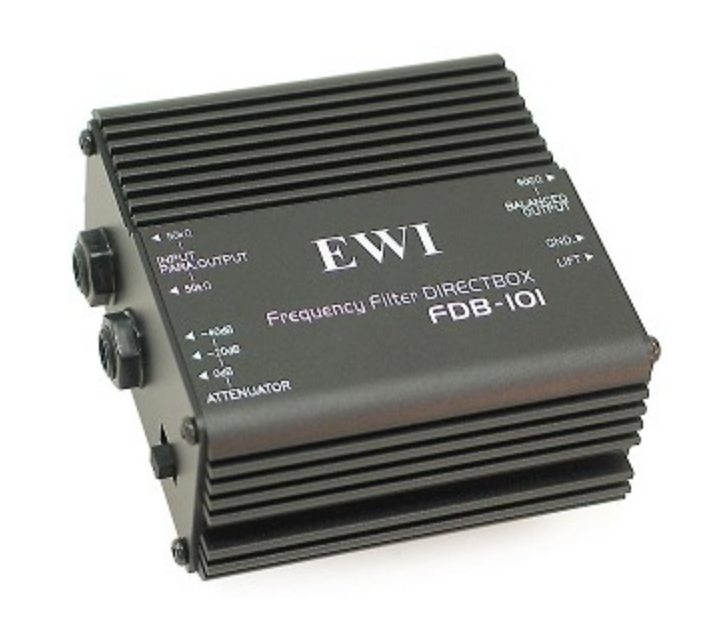
It sells for
about $30, and is available only from Audiopile https://audiopile-net.3dcartstores.com/FDB-101
On the other end of the price spectrum, the LR
Baggs Venue DI that I use for my acoustic guitars has 5 band
equalization, a mute switch, a boost switch, a notch filter,
and a phase reverse switch, in addition to an excellent
quality DI transformer, and sells for $300.
There are many other DI boxes available between
these two price and quality points, but I don't think they
sound any better than the EWI.
If you play an acoustic guitar, you should always
have a DI with you, wherever you go to gig. If a
professional sound company is doing the sound, they should
have a half dozen DI boxes available for the band to use,
but it never hurts to have your own, just in case.
With your DI, you can also patch into any mic jack in the
chapel to perform at church.
If you play a keyboard, and there are no XLR
output jacks, there are probably two 1/4" outputs (one for
left channel or mono, and the other for right
channel). If those outputs are unbalanced, a regular
1/4" TS guitar cord is what you will use to connect to the
PA, and you have the same situation as with a guitar: if you
are more than 20' away from the mixer, you should purchase
at least one DI (to run mono) to convert from a guitar cord
to a balanced mic cord.
But if your keyboard's 1/4" outputs are balanced,
you don't need a DI. There is no way to know if your
outputs are balanced or unbalanced without reading the
specifications at the back of the owner's manual for you
keyboard. Balanced and unbalanced jacks look the
same. You need to read the owner's manual to find out
if those outputs are balanced or unbalanced. If you
have 1/4" balanced outputs, you should purchase a pair of
1/4" TRS male to XLR male adapter cords, so you can plug mic
cords into them.
If you have a less expensive keyboard that has no
output jacks but only a headphone jack, there are ways to
get that into the PA but it's a little more involved.
My students can talk to me and I'll help you figure out how
to do it. Others reading this, you're on your own.
NOTE: most bands that have their own PA system run
mono, but when you play for bigger events where a
professional sound company is running the sound, they almost
always run stereo. Modern digital keyboards always
have stereo capability, and they sound better to the
audience in stereo. If your keyboard has two XLR
outputs, just tell the sound guy the keyboard has stereo XLR
outputs. He will plug two mic cords into them and pan
those channels on the mixer to left and right in the
PA. If you have balanced 1/4" TRS jacks, plug your
adapters into your keyboard and have the sound guy plug mic
cords into the XLR ends of them. If you have
unbalanced 1/4" TS jacks, plug guitar cords into them and
tell the sound guy you need two DI boxes to run stereo.
WIRELESS INSTRUMENT SYSTEMS
What if you
want to be cordless on stage? What are the best
systems to replace guitar cords, and what are the tradeoffs?
In the past, nearly all professional guitar
players chose cords. That was because cordless systems
had a loud hissing noise, poor frequency response in the
high register, terrible signal to noise ratio, and pathetic
dynamic range. They destroyed the musicality of what
was played. In fact, it is not an exaggeration to say
that the worst cord sounded better than the best
cordless.
However, in just the last few years, huge
improvements have been made in digital cordless
technology. Today, there are cordless systems for
which the drop in sound quality is low enough that it is
hardly noticeable in live performance.
For acoustic sets, when every bit of tone matters,
and I don't need to move around on the stage, I still use my
George L. cords for my guitars. But for rock sets,
there are a couple of affordable wireless systems that are
so good that I don't notice the difference at a gig, and I
love to use them because of the freedom to move around on
the stage without tripping on the cord.
The Xvive Audio U2 (below) is an excellent
sounding cordless system for electric guitar, bass guitar,
and most acoustic guitars. You just plug the
transmitter into your guitar, plug the receiver into your
amp or the mixer or snake, and turn them both on. They
have internal lithium batteries that are recharged with
USB.
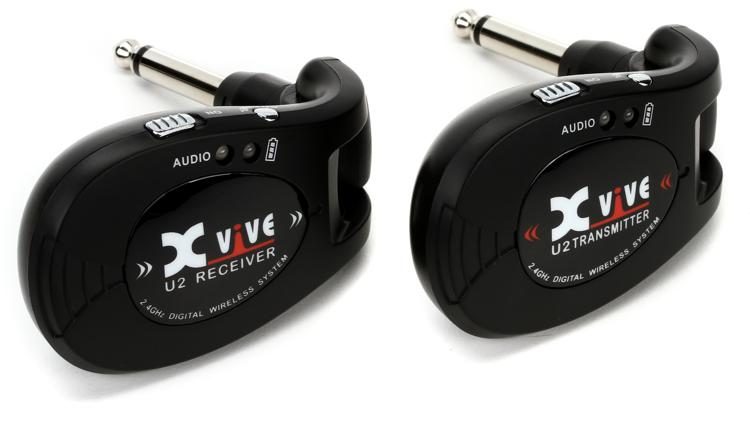
The system is priced at under $160 and is
available at Sweetwater. https://www.sweetwater.com/store/detail/U2Blk--xvive-audio-u2-digital-wireless-guitar-system-black
There is also another brand that I think sounds as
good as the Xvive for half the price: the Getaria GWS-X3 Pro (below). Its
specs on frequency response, dynamic range, and signal
to noise ratio are equal to or better than the
Xvive. It is available at Amazon for about
$85. For practicing in your house, the Getaria is
fine, but I can't recommend it for live
performance. That's because the receiver
automatically shuts off after 10 minutes of not
receiving a signal. That's REALLY bad news if you
play multiple instruments. You don't want to pick
up your guitar, strum a chord, and hear nothing because
the dumb receiver decided to turn itself off during a
band break or after a couple of keyboard songs.
For that reason, I recommend the Xvive for live
performance.
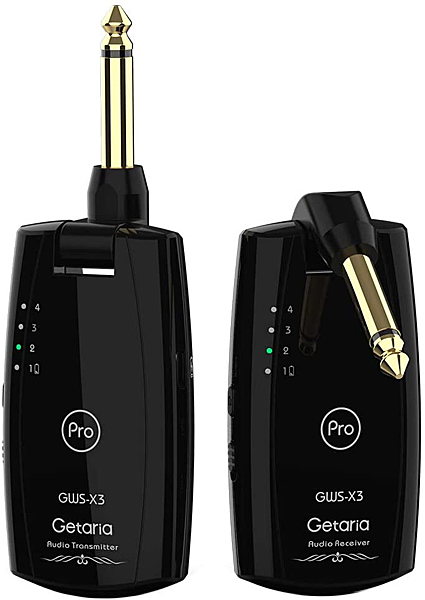
Wireless In-Ear Monitor Systems
Many professional artists are protecting their ears from damage by converting from using monitors and amps on stage to using in-ear headsets. In-ear headsets can be custom molded to your ears so that they block out the loud stage volume and, if you get a good sound tech to set up your monitor mix well, you'll hear exactly what you want to hear, and nothing else. Drummers can do this with an inexpensive corded headphone amp, but singers and guitar players need a cordless system.
The Xvive U4X (below) is the best inexpensive transmitter and receiver for your in-ear headset. The transmitter plugs into the mixer or snake return and the receiver has a strong belt clip to clip onto your clothing. The receiver also has a volume knob so you can control the volume yourself without trying to get the attention of the sound tech. Like other Xvive applications, the U4 has rechargeable internal lithium batteries that you recharge with USB.
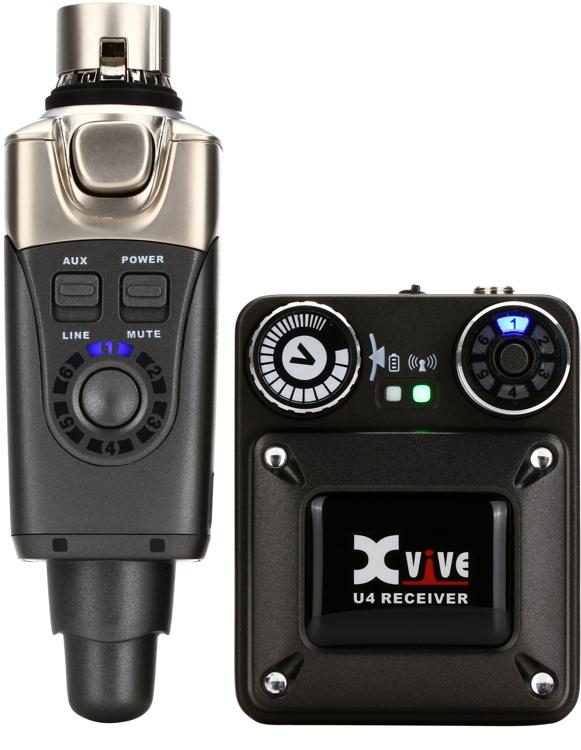
The Xvive U4X is available from Sweetwater https://www.sweetwater.com/store/detail/U4Set--xvive-audio-u4-wireless-in-ear-monitoring-system
SPEAKER CORDS
Speaker cords connect unpowered speakers and
monitors to the power amplifiers. They are designed to
carry significant watts of power, and thus have fairly high
gauge wires.
(NOTE: “Powered Speakers” do not need speaker
cords, because the amplifier is built into the same box as
the speaker. Instead of a single speaker cord, powered
speakers need two cords: a 110V AC power cord, and a
balanced mic cord or a guitar cord to receive the musical
signal from the mixer.)
Sadly, there are several different types of plug ends that
have been used on speaker cords that have been used over the
years. None of them are perfect, and they all have
some problems, but some are better than others. One of
the worst was "RCA" or "phono" (short for phonograph -- not
to be confused with "phone" which is short for telephone)
cords, like this:
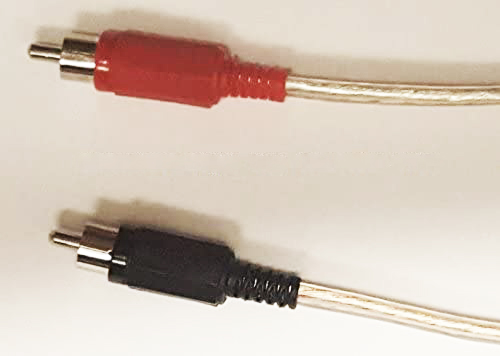
Cords with RCS/phono ends also were not used much
in professional settings. They were mostly used to
connect old record players, cassette tape decks, TVs, and
speakers to home entertainment systems. With luck,
you'll never see that kind of cord in your life. They
are horrible for speakers, and not that great for anything
else.
Speakers used in permanent applications such as
buildings and cars often have "bare wire" connectors, like
these:


Bare wire connectors are very good at carrying
electrical current to speakers, but very inconvenient for
use in portable PA systems.
The most common type of ends on speaker cords for
the last 50 years has been 1/4" phone jacks. The 1/4"
jacks were an unfortunate choice. We have already
discussed above the problem of confusion between 1/4"
speaker cords and 1/4" guitar/instrument cords. But
even without that confusion, 1/4" jacks are terrible
connectors for speaker cords because of the tiny connection
point of the tip of the jack with the spade in the plug,
which acts like a kink in a garden hose that restricts the
current flow. The jacks were designed by the telephone
company for shielded audio cords for very low voltage
applications, not for high wattage applications such as
speaker cords! Unfortunately, amps and speakers using
1/4" jacks are still commonly used.
Another type you might run into, that was much
better than 1/4" plugs, was called "banana plugs."
They were used on high quality amps and speakers through the
1980s, 1990s and into the 2000s. They looked like
this:
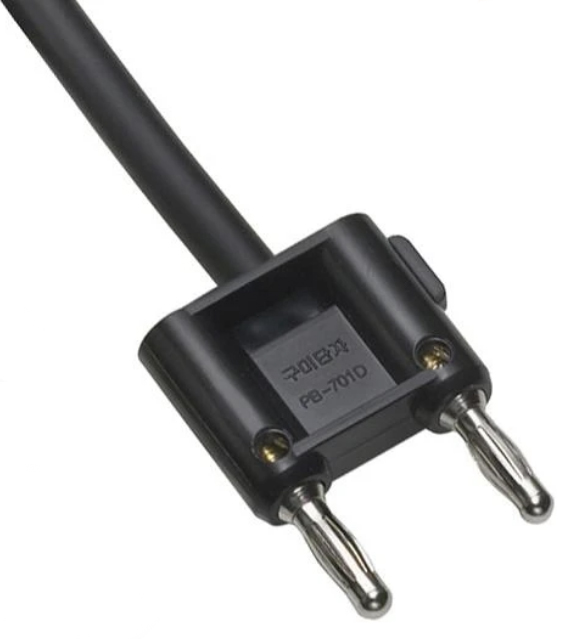
Banana plugs were better at carrying high voltage
current. The problem was, they could be plugged in
backwards, which would put the speaker out of phase.
Today, the preferred jacks and plugs for
professional PA systems are "speakON" types. These
connectors are capable of handling far more voltage and
carrying far more current than other jacks and plugs, and
they can't be plugged in backwards. They also have the
advantage that they lock into place and can’t fall out
during a performance. This is what they look like:

Even though they are the best option, speakON
jacks and plugs are not perfect. Unfortunately, they
have a couple of different wiring patterns, which means not
all speakON cables will fit all speakON jacks. You
have to make sure the speakON cable you buy is compatible
with your amp and speaker. A full discussion of that
problem is beyond the scope of this article. Without
going into such detail, you need to carefully look at the
photos of the ends of the connectors of a cord and compare
that to the inside of the jacks on your speaker and amp to
make sure they will fit. Look carefully at the
location and size of the plastic pins. Also read the
description carefully: for most band applications, you are
looking for "2 conductor" types.
These cables are often identified with a fraction
such as 11/2 or 13/4. The denominator is the number of
wires in the cable and the number of connections in the
plug. (Since speakers only need 2 conductors, this
numeral should be 2.) The numerator is the gauge of
the wires in the cable. The lower the number, the
thicker the wire and the more current it can carry (i.e.,
smaller numbers are better.) For small PA systems
(500W or less per speaker) and for monitors, a number of 16
(meaning 16 gauge wire) will work, but I recommend a
numerator of 14 or 13. For larger PA systems, I
recommend a numerator of 14 or 13 (meaning 14 or 13
gauge or thicker) for mains and 12 or 11 (meaning 12 or 11
gauge or thicker) for subs.
Sometimes instead of a fraction, the gauge is stated as
“AWG” (for example, 12AWG is 12 gauge).
For excellent, reliable, affordable speaker cables (speakON
and 1/4" only; they don’t carry banana), I recommend EWI
(available only at Audiopile): https://www.audiopile.net/speaker-cables
110V POWER CORDS
Sound equipment requires significant power. Vintage PA
ampifiers (prior to 1970) that used vacuum tubes used tons
of electrical power to produce only moderate amounts of
volume. Although tube electric guitar amps sound
fantastic, tube amps are not good for PA applications.
Professional “Class A” or “Class B” or “Class AB” solid
state amplifiers (1970-2010) that use large transformers,
huge capacitors, and banks of power transistors, also
require huge amounts of power. The difference between
tubes and pro solid state amps isn’t how much power they
use, it is what they do with that power. Professional
amplifiers of these types make tons of volume with huge
headroom and almost no distortion. These are still the
best sounding amplifiers for high volume venues. The
disadvantages are they are heavy, they are expensive, and
they get hot and need fans to keep them from overheating.
Newer systems with “Class D” amplifiers (2010 to the
present) use far less electricity to produce musical volume
than do older amps. They are also very
lightweight. But there is a disadvantage, and it is a
big one: they have no large capacitors that store
energy. So they rely solely on power that is coming
from the 110V power lines, every millisecond that they are
in use. This means that when the drummer kicks the
kick drum, or the guitar plays a power chord, or the bass
player plays a loud low note, there is no reserve power to
support that transient peak in volume. So even though
Class D amplifiers use less overall power, they require just
as much -- or more -- amperage capacity from the 110V system
as older amps do. If they can’t get it, they just
sound crappy.
For these reasons, no matter what type of amplifiers they
are using, rock, pop, and country bands need huge-amperage
110V power sources from the venue. And unfortunately,
they usually don’t get them. Too often, a band with a
nice PA system ends up plugging into a single 15a plug, and
sounds horrible the entire set. Or worse, they are
sometimes stuck on an electrical generator, which barely
produces enough watts for a moderate volume, and has ZERO
reserve for musical transient peak volumes.
In my experience, for a medium sized gig at medium volume,
no matter what class of amplifiers they are using, a band
needs AT LEAST two dedicated, non-shared 15a circuits,
connected to utility-provided power, on different circuit
breakers from each other, preferably on opposite sides of
the circuit breaker box (meaning they are on different wires
of the 220V from the power company). One circuit
should be used to power everything on stage (guitar amps,
bass amp, electronics, etc.) and the other should be
dedicated to power the PA system (up to 3,000 Watts).
If running such a system outdoors or at capacity, at least
two 20a circuits are needed. This does NOT include
stage lighting and visual effects. Those must be on
power circuits completely separate from the sound
system. When I write my band contracts when people
hire us, I include a paragraph specifying this power
requirement.
Every band should bring with them to every gig at least two
100-foot, 12 gauge extension cords. (NOTE: Extension
cords that go to your power strip must be 12 gauge. Do
not use 14 gauge -- or worse, 16 gauge -- extension
cords!!!! They cannot carry the power you need, the
sound will sag, and they can even be dangerous!)
You can buy 50’ 12g power cord at Lowe’s or Home
Depot. The ones at Harbor Freight are a little
stiffer, but they work just as well and are a little less
expensive.
NOTE: Bands that gig frequently with their own
sound system, if it is a fairly robust sound system, should
consider buying or building several 220V to 2x20a-110V
adapters that fit various kinds of 220V outlets, including
50a RV outlets and clothes dryer outlets. Such outlets
are usually wired better than ordinary 110V outlets.
110 VOLT POWER STRIPS
The important
thing with powerstrips is to make sure you don’t
exceed the rated amps (or watts) of the power
strip. For small accessories and so on the
Harbor Freight strips work fine (cheap beige ones
or yellow ones with the longer cord that cost a
little more). For larger electrical loads,
any industrial power strip will work. The
ones for building contractors are usually heavy
duty. Most of them handle up to
15amps. My favorite is the Furman (below)
SS6B because it has surge protection and also
because it is black and doesn't look stupid on
stage:
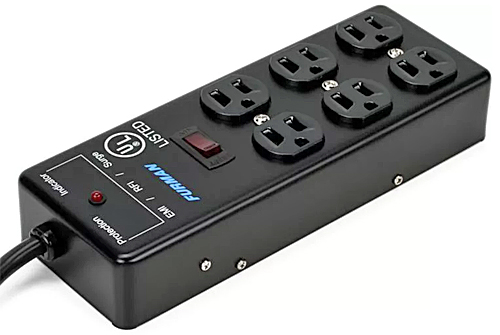
https://www.amazon.com/Furman-SS6B-Power-Conditioner/dp/B0002D017M
For rack
mounted PA systems, there are many Furman power
conditioner and spike protection models available
in various price ranges.
CORD TIES
One of the
best investments you can make is cord ties.
After you wind your cords correctly, you need
something to keep them wound that way and to
prevent them from getting mixed up with other
cords. There are various ways to tie cords,
but the easiest and best are Velcro style hook and
loop fasteners that permanently loop around one
end of the cord, and then loop around the entire
cord after it has been wound.
The Rip-Tie ties I used for many years that I was
very happy with were expensive and are now hard to
find, but I recently purchased a set of very
inexpensive no-name brand cord ties on Amazon
(below) that are identical in shape and very
similar in construction and feel. The
package includes two sizes; one for ordinary mic
and guitar cords, and a longer one for thicker
cords.
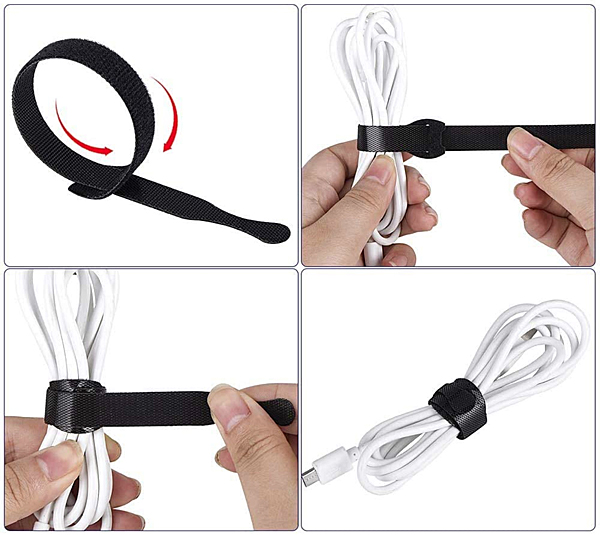
https://www.amazon.com/gp/product/B08H8J3MC1/ref=ox_sc_saved_title_4?smid=A1C0IOTTFIXH1G&psc=1
Another option is the Velcro 6” x ˝” OneWrap thin
reusable ties available at Lowe’s and Home
Depot. They are thinner, and a little more
annoying, but they work well and come on a long
roll.